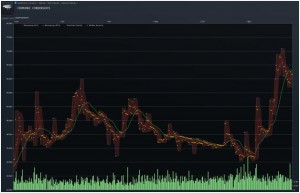 “A million and a half? Are you joking?”
“A million and a half? Are you joking?”
Wyl glanced over his shoulder at his corpmate, who sat across the room, flipping through screen after screen of Sinq Laison public market reports. “Troubles?”
“I’d rather be shot at,” muttered Ty. He tapped one screen closed and pulled up local private contracts available for the same products, but judging from his reaction, Wyl guessed the results weren’t any better. “At least with pirates, you know what’s going on: you want to kill them, they want to kill you. Simple. With this…” He flipped the screen to the side and spun in his chair, watching the ceiling. “I can’t tell if the prices on some of these modules are that high because people are stupid, or greedy, or if there’s actually a good reason.”
Wyl nodded, only half listening while he pulled up some production schematics. “Bet on greedy. You still trying to fit that old Vexor for the Duvole outpost?”
“It’s a tractor beam!” Ty threw his arms toward the ceiling. “I could understand a big price tag for the weaponized version of the tech — ship webs are a hot item, I get that — but an industrial tractor beam? For a million-five? It’s like someone misplaced a decimal point.”
“Mmm,” Wyl said. He’d pulled up two armor repair schematics he’d planned on loading into the station factories today, but frowned when he saw the production and material efficiency ratings — no one had optimized the blueprints, and it was going to cost them more than the corp was prepared to pay if he ran them as they were.
“Then there’s the new cargo containers,” Ty said. “CONCORD says we can’t haul passengers in airtight, vacuum-sealed environments, but I don’t see the problem. I mean it’s not like they’d spoil.”
“Mmm,” Wyl said. Maybe he could get Shoi on comms and see if she had some room in her schedule to tighten the plans up before they ran them. She was some kind of wizard with production research. They could…
“And even if they did go bad,” Ty continued, “that’s what the jettison button’s for, am I right?”
“Sure…” Wyl murmured, turning back to his terminal to pull up Shoi’s contact info. Halfway though the call code, his fingers stopped. “Wait. What?”
“Finally caught up to the rest of the conversation?” Ty smirked. “We’re both rubbish when we got a screen in front of us.”
“Sorry.” Wyl rubbed at his eyes. “I’m distracted. We’ve got to do something with these blueprint originals before we –”
“Hey!” Ty sat up. “Blueprints! Can we get a tractor beam blueprint?” He didn’t wait for the answer, spinning the chair back to his own terminal and pulling the market scroll back up. “Oh… yes we can. Hellooo, purchase order…”
“Ty,” Wyl began. “My production queue is pretty full right now.”
“Not a problem,” the pilot replied. “I’ll handle it.”
“Y–” Wyl coughed. “Sorry. You’ll handle it?”
“Sure.” Ty confirmed the purchase and sat back, lacing his hands behind his head. “I do run production jobs, you know.”
“I know,” Wyl was forced to agreed for the sake of accuracy; what his friend said was, technically, true. “But pulling into random stations with a cargohold full of looted serpentis wrecks and melting the components down to make more railgun ammo isn’t exactly the same as managing a whole factory op.”
“Hey, I’m not trying to step on your toes,” Ty smiled, raising his hands. “But I don’t want to clog up your workflow. I’ll deal with the tractor beams.”
Wyl’s brow creased along familiar lines. “Are you sure?”
“Sure I’m sure,” Ty popped out of his chair, looking far more comfortable in motion than he did hunched in front of a terminal. “It’s like they said back in Academy training when I was putting those Navitas frigates together: ‘Anyone who knows which way to hold the blueprint can build a battleship.'”
“Well…” Wyl said. “I suppose that’s technically true, but –”
“Sure. I know. It’s not that simple.” Ty shrugged. “I just want some tractor beams.” He grinned. “Maybe I’ll even make some extras and undersell those thieves in Dodixie.”
“That…” Wyl struggled for a suitable reply. “That would be nice. If that happened. Yes.”
“Excellent.” His friend rubbed his hands together. “Time to go get some raw materials. CB!” He shouted down the hallway.
“Yeah!”
“Feel like a mining expedition?” Ty winked at Wyl and strode out of the room.
Wyl watched him go, the corner of his mouth twitching in the very faintest hint of a smirk, quickly supressed.
“He’ll learn,” he murmured, then turned back to the comms window to call Shoi.
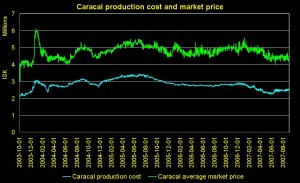 The crafting system in Eve is complex and not readily accessible without doing some research and having more than a few question and answer sessions between you and more experienced players.
The crafting system in Eve is complex and not readily accessible without doing some research and having more than a few question and answer sessions between you and more experienced players.
But on the surface, it looks pretty much like any other MMOs crafting system:
- Collect the raw materials.
- Process the raw materials.
- Get the “recipe” for the item you want.
- Use the recipe to make the item you want.
- Repeat.
That was the impression that I was left with after finishing the EVE new player tutorial several months ago, because the tutorial itself is kept simple: you are sent out to collect ore for a couple of very basic items, then led through the process of feeding a blueprint copy into the manufacturing queue in the tutorial station. In the end you have a few shiny frigates to sell on the market (probably to people who are going to reprocess them back into their component materials).
My experience with crafting in other MMOs is one that places the entire experience somewhat to the side of the “main” game — a nice-to-have (assuming it’s a good system), but nothing that will make you or break you if you ignore it, and (in many MMOs) so cumbersome and unbalanced that it often isn’t worth the effort.
Most importantly, in terms of drawing a comparison to EVE, in other MMOs the crafting system is something that can be entirely ignored by the playerbase in favor of simply killing bad guys, taking their stuff, and “repurposing” the best shiny bits as your own.
The reason I mention that last bit is because of the stark contrast it draws — if the players in EVE all ignored “the crafting system”, there would quite literally be no game to play. Miners would have no reason to mine. Scientists would have nothing to research. Pilots would have no ships to fly, no guns to mount on those ships, no ammunition for the guns, and (with the exception of NPC pirates) no one to shoot. Basically, no ships and almost no ship fittings enter the game if a player didn’t set out to build them. (With the exception of those fittings provided by NPCs via their violent demise.)
The daunting part of this isn’t in the basic system, but in the details. As I mentioned above, the core steps don’t seem to be any more complex than any other MMO: get stuff, melt stuff, remake the stuff into new stuff.
It turns out there’s a bit more to it than that.
“So…” Ty gazed out at the field of stars, the glitter of distant celestial bodies blocked here and there by the silent bulk of nearby asteroids. Bright beams of coruscating energy played over the nearest ore-laden rocks, super-heating the surface and blasting loose valuable chunks for the ship’s automated drones to retrieve. “Mining.”
“Yup.” CB’s voice crackled through the aging Vexor’s comm speaker.
“Kind of… peaceful, isn’t it?” He watched the cargo bay monitor crawl toward maximum capacity and prepared to jettison the ship’s current load in the direction of the orca-class industrial lurking just outside the field.
“Yup.” The comms crackled several times, indicating that CB was toying with the broadcast button, but he said nothing further.
“Yup,” Ty murmured, turning back to the impressive view, trying not to look at the chrono display that was counting down through this mining shift. He didn’t come out with the crews very often, and when he did it was usually as an informal bodyguard rather than a participant. His one dedicated mining ship was a refitted Vexor — the first cruiser he’d ever bought, long since retired from active combat roles and usually left as a gigantic dustcatch in the corp’s mining hangar — if memory served, most of the crew were semi-permanently seconded to one of his exploration ships.
The vex did the job well enough, though; the problem was more with the captain, not the ship. Ty knew mining was important; the heart, soul, backbone, spleen, and probably at least one lung in the body of New Eden — but he’d just never been able to spend too much time at it. Some did — he had it on good authority that CB read as he worked, and had a surprising collection of actual, physical books in his quarters that were probably worth more than the ship they were in — but Ty wasn’t much good if he had to sit still for too long. He didn’t know if that was the combat augments at work, or if he’d always been that way. Insert yourself into enough bodysleeves and those kinds of specific memories tended to fade.
Still… the play of light over the striated stones of the field, the awe-inspiring backdrop against which this simple, menial task took place — there was a kind of grace and beauty to the whole thing. Given enough time, Ty was sure that he could grow to appreciate the nuances of this kind of —
“Break break, break break,” CB’s drawled over the comms. “Pirates incoming. Ready guns.”
“Ohthankgod,” Ty breathed, and leapt for the combat console.
The process of creating a ship (or anything else) in EVE can be broken down into a few main topics.
1. Acquire Minerals
Everything but the most basic crafted items require a mix of many different kinds of processed minerals, which in turn come either from a variety of asteroid types, or by taking “loot” items from the destroyed wrecks of other ships and reprocessed them into their component elements. The degree to which mining dominates day to day life in EVE really cannot be overstated, but it can be demonstrated:
The most effective mining ship in EVE – a Hulk – costs over 200 million ISK just for an unfitted hull. Compare that to a Rifter – a small, cheap, fast, and fun-to-fly frigate that sells for approximately 224 thousand; roughly one tenth of one percent the cost of a Hulk.
At any given moment in EVE, the Hulk will will be the most-flown ship in the game.
The Rifter is fourth.
That’s how huge mining is.
“Two days,” Ty said. He tested the coffee in his hand, found the temperature bearable, and took a longer drink. “Two days of mining, I should add, which is like…” he waved his free hand through the air “fourteen days in regular-people time.”
Wyl chuckled. “Not your cuppa?”
“Has it ever been?” Ty shook his head. “It was alright. CB moved us to a field that gets hit by pirates more often than normal — no one knows why — to keep me busy. I don’t think I drove him too crazy.” He took another drink. “Probably.”
“Good haul?” Wyl asked.
Ty shrugged. “We sent the orcas back home… thirty five times in two days, and came back heavy ourselves, so…”
“Good haul,” Wyl nodded. “And no ships lost.”
“Damn straight,” Ty nodded. “Now it’s time to make the donuts. Did that blueprint come in?”
“The tractor beam? Yeah. Courier dropped it off this morning.” Wyl pulled it up on his monitor, tapped it once, flicked it onto his tablet, then tossed the slim device to Ty, who lifted it into the light. “The materials list…”
“HOW much?” Ty’s eyes widened, then narrowed. “That’s… jumping hell, I could build a cruiser with that much tritanium.”
“Aww, no…” Wyl shook his head. “A frigate, maybe.” He looked back at his terminal, where an image of the blueprint remained. “Okay, two frigates.”
“How…” Ty’s mouth worked, but nothing else followed the intial question. His eyes scanned the readout in more detail and widened again. “HOW many days per unit?!”
“Aura,” Wyl said, “can you tell Captain Delaney the Material Efficiency rating on the blueprint he’s accessing?”
“Of course,” the pleasant, non-specifically female voice purred from the room’s terminal speakers. “That blueprint is M.E. 0.”
Wyl nodded, ignoring his friend’s bemused expression. “How about the production efficiency?”
“Also zero, commander.”
“Thank you, Aura,” Wyl replied, indulging a habit of politeness toward the AI that his X-Os had always thought downright odd. He turned back to Ty.
“I don’t know what any of that means,” the captain muttered, dropping the tablet into his lap. “Except that I’m getting screwed.”
“You bought a basic blueprint off the open market — it’ll get the job done, but it’s the most generically-designed schematic possible — something that’ll run no matter what production facility you plug it into: Minmatar, Gallente, Caldari, or a Gurista pirate’s private station.” He crossed his arms and shrugged. “When you make something that works reasonably well everywhere, and it won’t work really well anywhere.”
“So… what? We just have to deal with it?”
“Of course not,” Wyl said, “we fix it.” He turned to his terminal. “We call Shoi.”
Blueprints are basically recipes, and if you’ve ever done crafting in an MMO, you probably get the basics of how they work — they let you combine a given quantity of minerals and produce something useful. In EVE, there are two types of blueprints: blueprint originals (“BPOs”) and blueprint copies (“BPCs”). The difference between the two isn’t about the final product (which is always the same) but about the efficiency of process to create the item it describes, and the fact that BPO efficiency can be improved, while a BPC cannot. Also, a Blueprint Copy can be used for only a limited number of runs before it is used up. Ed.: A cheap and evil means of planned obsolescence that companies like HarperCollins are currently working to perfect for ebooks.)
Blueprints have four basic stats:
- Number of runs – This dictates how many times you can use the blueprint. (only for BPCs, the BPOs are infinite)
- Base Production Time – How long manufacturing will take for one use of the blueprint, if everything were perfect.
- Material Efficiency (“ME”) – This dictates how much material will be wasted on each run. Higher efficiency means less waste, but the effect of higher efficiency increases at a logarithmic rate (which means that as the level of mineral efficiency increases, each additional level eliminates less and less waste), which most MMO players will recocognize as the math behind the concept of Diminishing Returns.
- Production Efficiency (“PE”) – This dictates how long manufacturing one run of the blueprint will really take. Like mineral efficiency, the benefit of raising this rating suffers from diminishing returns.
Right-out-of-the-box BPOs are inefficient both in the time they take to run and the resources they require. This isn’t a problem for the typical amateur crafter who carries a Flameburst Missile blueprint around in his hold to make more ammo every few weeks — the scale is small and the time spent is minuscule compared to larger projects — if you lose ten percent of the ore to “waste” and the run takes 25 minutes instead of 20, it doesn’t matter that much… until you start to work on a Battlecruiser and waste so much ore you could have built a second, smaller ship, and the job takes 45 days instead of the 30.
Obviously, this is unacceptable for the serious crafting player trying to make money off of ship and module production.
As already explained, only a BPO can be researched, so while the ME and PE rating on a Blueprint Copy is fixed, they can be improved on a BPO, and really, the should be before they’re used for anything significant; a brand new BPO always starts with both ME and PE at zero, but that can be changed.
That’s where SCIENCE comes into the process.
Shoi swung into view on the screen, dropping into a chair and shoving her hair back from her face. “Hey, Wyl. There’s two more days on those jobs you asked about.” She looked up at the screen, then looked again. “What’s he doing there?”
“Ty wants to do some BPO research,” Wyl said, his voice even.
Shoi frowned. “You said he –”
Wyl cleared his throat.
Shoi’s eyebrows shot up, the tech-style tattoo over her right temple shifting as she stared at the screen. She shook her head. “Whatever. I don’t actually care. What’s the blueprint?”
Wyl tapped a few keys, and Shoi’s eyes flicked to the side. “Tractor beams. Cool. I can start them in… four days, and get them solid in –”
“I want to do it,” Ty said, cutting in over the audio signal.
Shoi paused, looking at Wyl rather than Ty. “Can he even run a terminal with blowing a circuit?”
“I’ve got my research certificate,” Ty said. “Caille University.”
Shoi snorted.
It was Ty’s turn to raise his eyebrows. “Listen, I’m not a real scientist; I get that. But I’m not curing the plague; I’m trying to make this schematic suck less. That’s it. Can we work on it, or do I need to learn a secret handshake first?”
Shoi rolled her eyes. “Drama queen.” She looked at Ty through the screen, her head tilted, then nodded. “Fine. What ME are you aiming for?”
Ty crossed his arms, sure he knew what was coming next. “I have no idea.”
Shoi said nothing. After, a few seconds, she reached offscreen and retrieved a water bottle, emptied it in one long pull, wiped her mouth, and let out a short but powerful burp.
“Okay,” she said. “Lesson time, Caille University. Siddown.”
Ty hesitated, then pulled up a chair when Wyl motioned his direction, below the line of the comms camera.
Shoi tapped a few keys and their screen split; one side displaying the young woman with the old eyes, the other an image of the blueprint, overlayed with a green and red grid that shifted as she altered settings on her end of the comms.
“Okay,” she said, “work with me here. This is your blueprint — basic piece of crap with no kind of optimization.” Her eyes flicked toward Wyl. “Where are you going to run this thing?”
“Here,” Wyl said, “one of our standard assembly lines.”
She nodded. “Alright, so we spin on down to the bottom and look at the ME estimates. She tapped her screen and one of the boxes lit up and pulsed. “Right here, you can see the current Material Efficiency is 0 which, as previously mentioned, is crap in a can.”
Ty squinted. “What’s that column to the left of it?”
“That’s the perfect column — that’s how many resources you need to roll off one of these units in an absolutely ideal environment. It… isn’t a thing that can happen. It’s functionally unachievable.” Shoi’s mouth twitched downward. “Probably.”
She tapped the first column again. “This is what you’re working with, though. ME: 0, which means a lot of waste — roughly ten percent of the stuff you put in the hopper will be lost: product-destroyed-in-process, general mistakes and boneheadedness, stuff getting lost in the warehouse, whatever.” She moved her finger on the screen, and the columns to the right lit up. “These are the numbers you start to get as you tighten up the material efficiency and reduce waste.”
Ty peered at the screen. “So… okay, it looks like if I can get the ME up to ten, the loss drops to around one percent.”
“Right,” Shoi nodded, then blinked and glanced at Ty. “Good, actually. Good catch.” She tapped the screen. “Somewhere between ME10 and ME20, give or take, you start to hit serious diminishing returns in terms of research time. Getting things down to 1% is pretty easy and relatively quick. Anything past that, approaching zero, gets harder and harder.”
“Got it.” Ty chuckled. “Damn, the chart goes out to ME 300. Who would ever push something out that far?” No one replied, and he looked up from the screen. “What?”
“Shoi optimizes our blueprints out to either ME 50 or 100,” Wyl murmured. “Minimum. Her personal BPOs go…” Wyl’s mouth quirked, “…somewhat higher.”
“Go ahead and complain, baldy,” Shoi muttered.
Wyl shook his head. “Not at all — I love it, and my crew loves it too. It was a compliment; most people don’t have that kind of patience.”
“I’m probably one of em,” said Ty. He looked at Shoi. “How long did you say for ME 10?”
“On this?” Shoi glance at the blueprint, then shrugged. “Two and a half days, give or take.” She squinted up at the ceiling. “Five days, if you’re going to sleep.”
“If I’m –” Ty began but stopped when Wyl cleared his throat. “Right. Are there any stations open with your alliance?”
“Sure,” Shoi said, tapping the keyboard again. “In two days. Bring lots of shiny monies — they don’t exactly starve with the prices they charge per day.”
Research is a time and money sink that slowly improves both the material cost and time required for the blueprint being researched. Only a BPO can be researched since a BPCopy has fixed values — the same ratings as the original the copy was made from, at the time it was made. (There’s actually a good market for those scientist characters who want to sell limited-run Blueprint Copies made from well-researched and highly-optimized originals.)
Research is meant to help you improve your BPO before using it in production, since a ‘raw’ BPO off the market is generally both slow and wasteful. Research is performed either at NPC-owned stations (where the wait time for an open slot can range from 15 to 45 days), or PC outpost stations or Player Owned Structures (player-owned orbital towers with research facilities installed). Both player facilities have much shorter or non-existent wait times, but are either locked to anyone outside the controlling corporation or open only for a large per-use fee determined by the players who control it.
When you have a BPO you want to research, you first look for a station with open slots for the research type you want to perform. Publicly available Manufacturing, Production Efficiency research, and Blueprint Copying slots are easy to find — Material Efficiency… not so much. On top of that, ME research is notably more expensive, but undeniably worth it. For low-end equipment like ammunition, missiles, or smaller ships, an ME around 10 to 12 is probably enough, while bigger items rate more research time spent.
The good news: once your research job has started, you can go do something else — the computer is crunching numbers, and doesn’t need you around. Your research will take hours, days, or even weeks, depending on the complexity of the BPO and the Material Efficiency you’re aiming for.
Once done, the blueprint, now improved as you’ve specified, will be ready to be copied or used in production.
“Welcome back,” Wyl slid a cup of coffee over to Ty as his friend sat. “How was the research?”
Ty grimaced.
Wyl smirked, quirking his eyebrow. “That good?”
“No, it was fine,” Ty shook his head. “It was good. I learned a lot. I feel a lot stupider than I did when I went over there, but I learned a lot.”
Wyl nodded. “Shoi has the effect,” he said. “Don’t feel bad — in all seriousness, she’s one of the best in New Eden.”
Ty grunted, but didn’t respond. Wyl looked him over, considering, then clapped his hands together, rubbing the calloused ridges together until they blurred. “Ready to build some tech?”
Ty eyed him warily. “There isn’t anything else I need to do first?”
Wyl shook his head. “You’ve got the materials. You’ve got a blueprint that won’t make the production crew cry. We’re good to go.”
Ty’s frown slowly faded, replaced millimeter by millimeter with a thin but durable-looking smile. “All right,” he stood up. “All. Right.”
The main difference between the interface is that, for manufacturing, you also need minerals handy. The in-game interface is largely the same. Again, you simply plug in your desired end result, set things to cooking, and then go do something else.
Wait the required amount of time, and you’ve got your product.
… hopefully with a production cost somewhat less than it would have been if you’d just bought the things off the market.
“What happened?” Wyl said. His eyes scanned the room.
“Hmm?” Ty looked up from his screen, the bemused glaze on his eyes fading. “Oh, I…” he waved vaguely to his left. “I kicked the cabinet.”
Wyl followed the direction his gesture and noted the fresh dent. “Troubles?”
“Just the tractor beams.”
“Ah.” Wyl entered the room and sat. “I heard the job finished up today” he added. “Twenty units. Pretty impressive.”
“Yeah,” Ty continued tapping at his screen. “I only needed five, but I though I’d sell the rest.”
Wyl nodded, his expression neutral. “You’d mentioned that.”
“So I ran a cost analysis,” Ty continued, “figuring my time spent out with C’s crew, and the week at Shoi’s, and her alliance’s fees, and the cost of the original blueprint.”
“Trying to figure out a fair price, right,” Wyl nodded. “And?”
“And…” Ty leaned back, his face set in a wry frown, “the number I came up with was a million and a half.”
“Per u–”
“Per unit, yes.” Ty rolled his eyes, then looked at Wyl, his eyes glinting. “I don’t honestly know how you do it.” He waved at the screen. “I don’t know how ANYONE does it — every single thing on the market is something at least that complicated — usually moreso. Hundreds of billions of ISK worth of product sold every day, and someone — some poor bastard like me — built every damned thing up there. It’s…” he shook his head.
Wyl let his friend’s voice trail off, then: “Impressive?”
“Awe inspiring,” Ty replied almost instantly. He nodded back toward the screen with his chin. “That damned market might be the most reassuring proof of the resilience of life I’ve ever seen in this whole –” He cut himself off, shaking his head. “Sounds stupid.”
“Not at all,” his friend replied.
The pair sat in silence for some time, watching the silent market scroll play across their screens.
“So,” Wyl asked, “all done with this grand adventure? Time to go back to saving the universe from pirates for a reasonable fee?”
Ty looked down, clearing his throat. “Actually…”
Wyl raised an eyebrow.
“I’ve been looking at the market,” Ty began, “and thinking about the price on railguns…”
[[This post took a long time to put together, partly because I (like Ty) had to figure out how the system worked before I could write about it even semi-intelligently. In this effort, I was assisted by the ever-patient and shockingly-knowledgeable players behind Shoi and Wyl, and I’d need to thank them (and CB) for their help. I’ve barely scratched the surface of crafting, science, research, business, and industry in EVE, but I can’t think of better allies on the trip.]]
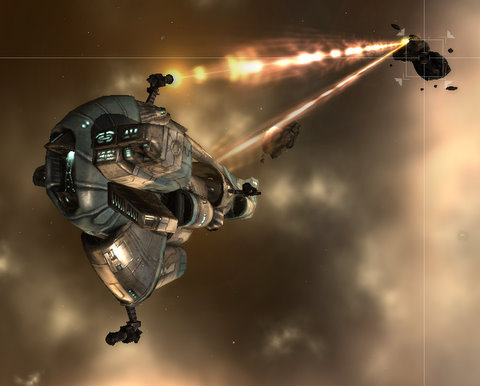
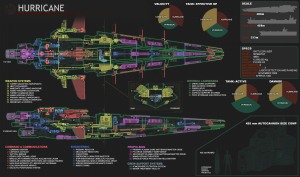
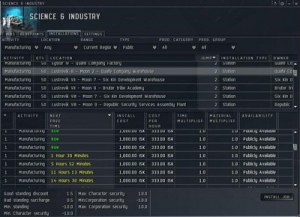
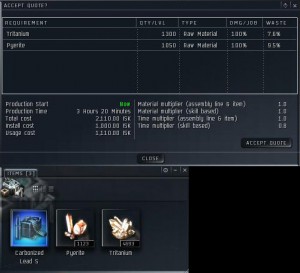
One comment
Comments are closed.